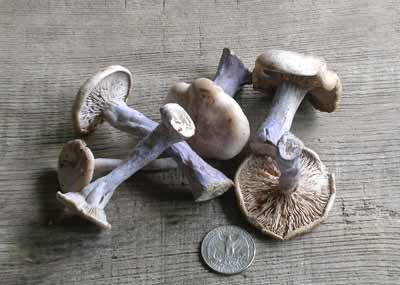
The wood blewitt grows on the edges of woods. The stem, cap and gills are an unmistakable bright lilac blue. They have a fresh, clean flavour which is excellent with potatoes. They are related to the Japanese matsutake mushrooms and can be substituted. (If gathering mushrooms you must be absolutely certain what you have before you eat them as many are very poisonous.)
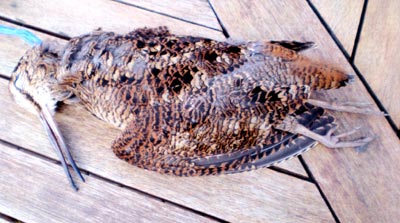
Woodcock, or 'snipe of the woods'. The season in England is from 1 October to 31 January while the season in Scotland starts a month earlier on 1 September. It is a very fine, pigeon-sized, game bird which inhabits boggy woodland and which is usually cooked undrawn, with only the gizzard removed, commonly hung for 1-3 days. The trail, or entrails, are considered a great delicacy. When the woodcock is served the trail may be removed from the bird, finely chopped with bacon or foie gras, made into a paste with a little brandy and spread onto fried bread, the woodcock served on top. A woodcock constitutes one portion.
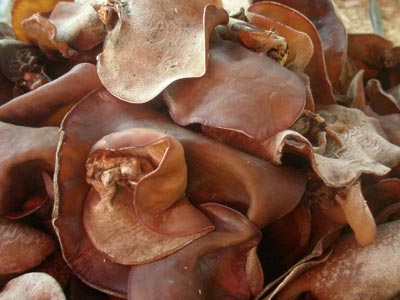
The wood ears commonly include the Judas's ear fungus, so-called as it is usually found on elder, the tree from which Judas is reputed to have hanged himself. It may also refer to the cloud ear mushroom. These mushrooms are often grown on oak logs and are available fresh or dried. If dried they are black and are broken into small pieces. They swell hugely when soaked. If fresh, they are slightly crunchy and have a bland flavour but take up the flavour of the foods with which they are cooked. Silver ears are an albino variety of these large dark mushrooms. They should not be fried as they explode, but should be stewed for at least an hour. If dried they may be ground to a powder, in which form it may be used to flavour soups and stocks. Unlike most mushrooms this can be found all year round. (If gathering mushrooms you must be absolutely certain what you have before you eat them as many are very poisonous.)
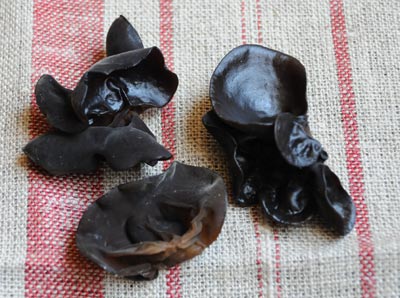
Wood ear fungus. The wood ears commonly include the Judas's ear, cloud ear and silver ear fungus. Generally found dried, they should not be fried but stewed for at least an hour with other ingredients.
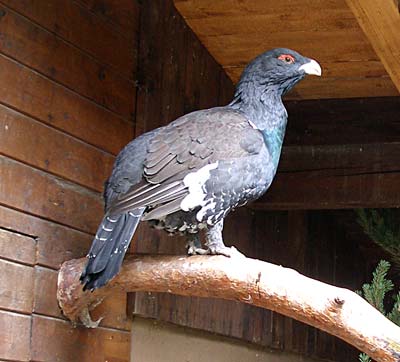
Capercaillie. Black cock. Wood grouse. This large, grouse-like game bird is found in coniferous woodland hills of Scandinavia and Baltic countries, Scotland, the former Yugoslavia and Central Europe with some in the Pyrenees. They are usually found on the floors of coniferous forests during summer and up in the trees in winter.
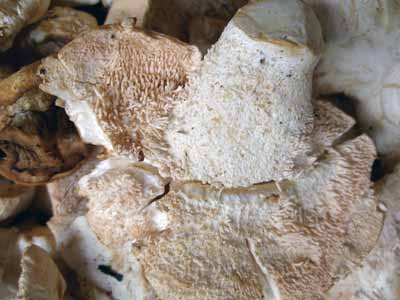
Hedgehog fungus. Cream-coloured mushrooms, excellent to eat, easily found in woods from late summer to late autumn (US: fall). They have a sort of downy white stem leading up to a cap which is centrally depressed and under which are masses of little spines, giving the mushroom its English name. It is quite a good mushroom to collect as it is easily distinguished from other mushrooms, is a relative of the chanterelle, and, like it, has good flavour and good retention of texture on long cooking.

The Whitefaced Woodland sheep originated in the South Pennines. It is also known as Penistone after the Yorkshire town where sheep sales have been held since 1699. It is thought to be closely related to the Swaledale and the Lonk. One of the larger of the English hill breeds, the breed has no wool free, white, face and legs. Both sexes are horned and the horns in the males are heavily spiralled.
Flowers, leaves and pods of woodland sorrel can be eaten and have quite a tangy flavour and are sometimes added to salads, or can be chewed as they are said to have thirst-quenching qualities. This has resulted in the leaves being used to make a lemony drink or it may be brewed as a herbal tea, though the flavour is a little dull. Apparently the juice can be used as a substitute for vinegar.

The Whitefaced Woodland sheep originated in the South Pennines. It is also known as Penistone after the Yorkshire town where sheep sales have been held since 1699. It is thought to be closely related to the Swaledale and the Lonk. One of the larger of the English hill breeds, the breed has no wool free, white, face and legs. Both sexes are horned and the horns in the males are heavily spiralled.